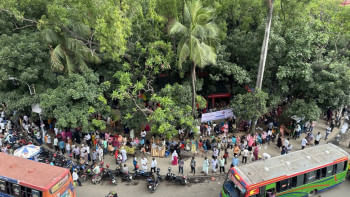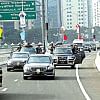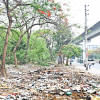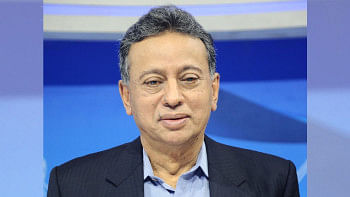Perils of Panthakunja Park

Champa (40) has been running a tea stall for the last 16 years beside the Kathalbagan wall of Panthakunja Park, under the shade of a banyan tree. It is the only surviving tree in the western part of the park. Once a lush green haven in the middle of the busiest spot in the city, the park is now being stripped of its greenery due to the construction of the elevated expressway extension project, which has been mired in controversy from the start. A Tk 19.2 crore project was undertaken for the "beautification" of the park in 2018, but it has since been halted. DSCC argued that the renovation work was stopped as the pillars of the expressway might fall within the park's area.
Building an elevated expressway was not a priority in the 2005 Strategic Transport Plan. Other infrastructure projects, such as commuter trains and Bus Rapid Transit, were at the top of the list. Still, the previous government initiated the elevated expressway project in 2011. The project was supposed to be completed by 2014, but it was extended to 2016 and finally to 2024. The main design for the expressway was changed multiple times due to a lack of coordination among different government entities, including both the north and south city corporations, RAJUK, and the Dhaka Transport Coordination Authority. The main idea behind the expressway was to let people travel through Dhaka on a circular road, bypassing the already cursed city traffic. However, multiple design revisions resulted in placing the expressway ramps inside the city, which worsened the situation for city dwellers. It is incomprehensible why such a project was undertaken with foreign loans, as it may benefit only a small section of society while imposing economic, environmental, and social burdens on the entire population.
The previous government filled up a waterbody in the metropolitan area, violating the Environment Conservation (Amendment) Act 2010, and built more than 30 pillars for the expressway project, ignoring widespread protests and warnings from experts and environmental activists. According to media reports, the filling up of parts of Hatirjheel Lake, the delicate water retention system of the area, disrupted the natural water flow and reduced the lake's capacity to absorb excess rainwater. As a result, waterlogging in the area has worsened, causing irreparable damage to biodiversity and aquatic life. Unfortunately, the previous government had shameless support from certain so-called environmental activists, some of whom were involved in the elevated expressway's landscaping.
After the fall of the fascist regime, one would have expected that all these anti-people, anti-environment projects, undertaken in violation of the country's constitutional laws, would be reassessed, reevaluated, and ultimately canceled. But to our surprise, the elevated expressway project was resumed last month, and a huge portion of Panthakunja Park was stripped of its natural beauty. The entire area now lies barren. Kingfishers and doyel birds keep circling the area, searching for their lost habitat. After the tall gogon shirish trees were cut down, a colony of kites lost their home and has now taken refuge on the metro-line cables.
It may sound cliché to write about the importance of parks and open spaces in the city, but it seems that even after the fall of an autocratic regime, the challenges for environmental activists remain the same. Dhaka has less than seven percent of the tree coverage that a geographical area should ideally have, against the recommended 25 percent. Parks in cities help maintain and protect the environment, encourage active lifestyles, reduce health costs, make cities more resilient, manage stormwater, mitigate flooding, increase community engagement, reduce crime, and, of course, cleanse the air and improve public health. However, Dhaka South City Corporation (DSCC) has only 27 parks for its 75 wards, while Dhaka North City Corporation (DNCC) has 23 parks for its 54 wards. The utter disregard for the maintenance of these parks was evident during the previous regime. From Suhrawardy Udyan to Anowara Park, Tajuddin Park, and the trees of Satmasjid Road, environmental destruction was widespread. Now, during the interim government's term—a government responsible for fulfilling the people's mandate—the trees of Panthakunja have been destroyed mercilessly.
Leaving aside the destruction of the park, how will the construction of the expressway impact the roads below? The environmental impact assessment of the report itself states that building this expressway will have dire consequences on the streets below, particularly in the Palashi and Katabon areas. One can easily assume that upon completion of the project, the entire route of the expressway—through Hatirpool Bazar, Katabon, Dhaka University, Palashi, and BUET—will seriously impact traffic and the environment underneath, as has been seen with several other flyovers in the city.
The sit-in protest by the activists of the Bangladesh Tree Protection Movement, which began on December 14 last year, has now been going on for 40 days. On the 11th day, Muhammad Fouzul Kabir Khan, adviser to the Ministry of Road Transport and Bridges, Syeda Rizwana Hasan, adviser to the Ministry of Environment, Forest and Climate Change, and Adilur Rahman Khan, adviser to the Ministry of Housing and Public Works, visited Panthakunja Park and Anowara Park. They promised to free up Anowara Park by March 25, 2025, as per the demands of the activists. They also promised to organise a meeting with the protesters regarding the issue of Panthakunja Park. On January 2, the protesters were allegedly attacked by environmental activists, including many from Bangladesh Poribesh Andolon (BAPA) and Greenvoice. Braving threats of attack, severe cold, mosquitoes, dust, and noise pollution, the activists of the Bangladesh Tree Protection Movement are continuing their peaceful protest, halting the construction of the elevated expressway. We have yet to hear from the advisers regarding this issue.
As a country at the forefront of the climate catastrophe, we seriously need to rethink our approach to the environment. The question remains: will the interim government reevaluate these environmentally destructive projects, or will it be business as usual? If the implementation of such projects continues, what has truly changed after the July revolution?
Naim Ul Hasan is coordinator of the Bangladesh Tree Protection Movement.
Views expressed in this article are the author's own.
Follow The Daily Star Opinion on Facebook for the latest opinions, commentaries and analyses by experts and professionals. To contribute your article or letter to The Daily Star Opinion, see our guidelines for submission.

 For all latest news, follow The Daily Star's Google News channel.
For all latest news, follow The Daily Star's Google News channel. 










Comments